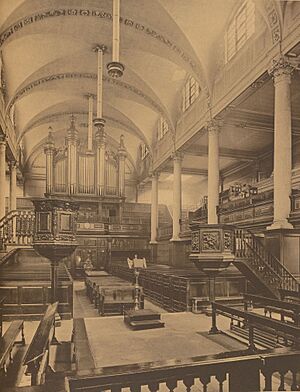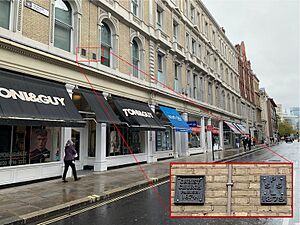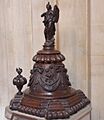Christ Church Greyfriars facts for kids
Quick facts for kids Christ Church Greyfriars |
|
|---|---|

Christ Church Greyfriars, seen from the southeast
|
|
| Location | Newgate Street, London |
| Country | England |
| Denomination | Anglican |
| Architecture | |
| Heritage designation | Grade I |
Christ Church Greyfriars was a famous church in London, England. It stood on Newgate Street, right across from St Paul's Cathedral. This church started as a monastery church in the 1200s. Later, it became a regular parish church after monasteries were closed down in England.
The church was destroyed in the Great Fire of London in 1666. It was then rebuilt by the famous architect Sir Christopher Wren. Sadly, most of the church was destroyed again by bombs during World War II. Only the tower remained standing. Today, the ruins of the church have been turned into a peaceful public garden.
Contents
History of Christ Church Greyfriars
The First Church: Gothic Style
Christ Church Greyfriars began as the church of a Franciscan monastery. The Franciscans were also called 'Greyfriars' because of their grey robes. The first church was built in the mid-1200s. But soon, a much bigger church was started in the 1290s. It was finished around 1360.
This new church was the second largest in medieval London. It was about 300 feet (91 meters) long and 89 feet (27 meters) wide. It had at least eleven altars. Queen Marguerite of France, wife of King Edward I, helped pay for it. Many important people were buried here. These included Queen Isabella, wife of King Edward II, and her daughter Joan, who was Queen of Scotland. The heart of Queen Eleanor, wife of King Henry III, was also buried here.
In 1429, Richard Whittington, who was Lord Mayor of London, started a library connected to the church.
The monastery was closed in 1538 during the English Reformation. This was when King Henry VIII changed the official church in England. Many parts of the church were damaged during this time. Tombs were sold for their valuable materials, and monuments were ruined.
In 1546, King Henry VIII gave the church to the City of London. A new parish, called Christ Church, was created. The old monastery buildings later became Christ's Hospital school. The church then became the main place of worship for the school's students.
Wren's Rebuilt Church
The medieval church was completely destroyed by the Great Fire of London in 1666. Sir Christopher Wren was put in charge of rebuilding many churches, including Christ Church. He also rebuilt St. Paul's Cathedral.
The new church was smaller than the old Gothic one. It was 114 feet (35 meters) long and 81 feet (25 meters) wide. It cost about £11,778 to build. The church and its tower were finished in 1687.
The tower stood at the west end of the church. It had a simple entrance and windows with fancy decorations. Large carved pineapples, which symbolize welcome, were placed on the corners of the main church roof. The church also had special buttresses on its east and west walls. These were unique among Wren's churches.
Inside, the church had a main area (nave) and side sections (aisles). These were separated by tall columns. The church had large, clear glass windows. This made the inside very bright. There was a big wooden altar screen and a carved pulpit. Galleries were built over the side aisles for the students of Christ's Hospital school. The organ, built in 1690, was on the west wall.
The tall steeple, about 160 feet (49 meters) high, was finished in 1704. It had three levels, getting smaller as they went up.
Over the years, some changes were made to the church. In 1760, a small building was added. Stained glass windows were also put in.
Christ Church was an important place for music and society in London. The Lord Mayor of London attended a special service there each year. Famous musicians like Felix Mendelssohn and Samuel Wesley played the organ.
The boys from Christ's Hospital school continued to attend services. They sat in the galleries. Famous writers like Samuel Coleridge and Charles Lamb were among these students.
Decline and Destruction
In 1902, Christ's Hospital school moved out of London. This meant fewer students came to the church on Sundays. Over time, the number of people attending services at Christ Church continued to drop. This was a common trend as many people moved from the city center to London's suburbs. By 1937, only 77 members were left.
The church was badly damaged during the Blitz on December 29, 1940. This was a very strong air raid on London during World War II. A firebomb hit the roof, and the church caught fire. Many other churches by Christopher Wren also burned that night. At Christ Church, the roof and ceiling fell into the main area. Only the tower and the four main stone walls remained standing. They were damaged by smoke and weakened.
After the War
After the war, in 1949, it was decided not to rebuild Christ Church. The church's remains were recognized as an important historical building in 1950. In 1954, the Christ Church parish joined with the nearby St Sepulchre-without-Newgate parish.
The steeple, which had survived the bombing, was taken apart and rebuilt using modern methods in 1960. Parts of the church's walls were taken down in 1962 to make way for a wider street. In 1981, new offices were built next to the ruins.
In 1989, the area where the main part of the church used to be became a public garden and memorial. The lower levels of the tower were used as rental space.
In 2002, the area around Christ Church was renovated. The street was returned to its original path. The churchyard was cleaned up, and its metal railings were fixed. In 2006, the tower and spire were turned into a modern private home. The main church area remains a memorial garden today.
Important Burials
Many notable people were buried at Christ Church Greyfriars over the centuries. Some of them include:
- Isabella of France, Queen of England and wife of King Edward II
- Margaret of France, Queen of England and second wife of King Edward I
- Joan of the Tower, Queen of Scotland and first wife of King David II
- Thomas Malory, who wrote the famous book Le Morte d'Arthur
- Richard Baxter, a well-known theologian (religious scholar)
- Kenelm Digby, a courtier and philosopher
- Lawrence Sheriff, who founded Rugby School
See also
 In Spanish: Christ Church Greyfriars para niños
In Spanish: Christ Church Greyfriars para niños
- List of Christopher Wren churches in London
- List of churches rebuilt after the Great Fire but since demolished
Images for kids







